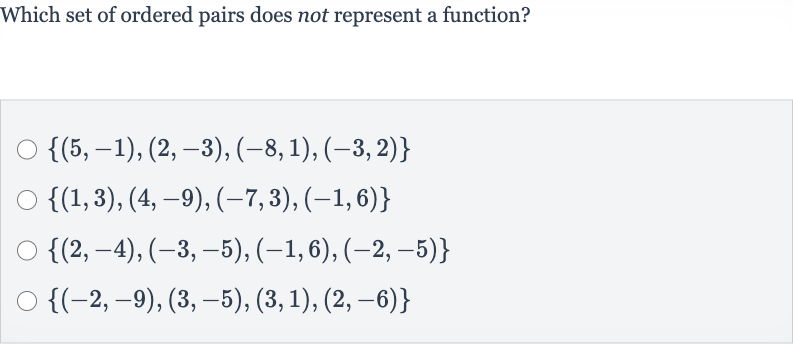Full solution
Q. Which set of ordered pairs does not represent a function?
- Check Unique -Values: To determine if a set of ordered pairs represents a function, we need to check if each input (-value) is associated with exactly one output (-value). A function cannot have the same input paired with different outputs.
- First Set Analysis: Let's examine the first set of ordered pairs: . We need to check if any -value is repeated with a different -value.
- Second Set Analysis: In the first set, all -values are unique: , , , . Since no -value is repeated, this set represents a function.
- Third Set Analysis: Now, let's examine the second set of ordered pairs: . Again, we check for any repeated -values.
- Fourth Set Analysis: In the second set, all -values are unique: , , , . Since no -value is repeated, this set also represents a function.
- Fourth Set Analysis: In the second set, all -values are unique: , , , . Since no -value is repeated, this set also represents a function.Next, let's examine the third set of ordered pairs: . We check for any repeated -values.
- Fourth Set Analysis: In the second set, all -values are unique: , , , . Since no -value is repeated, this set also represents a function.Next, let's examine the third set of ordered pairs: . We check for any repeated -values.In the third set, all -values are unique: , , , . Since no -value is repeated, this set represents a function as well.
- Fourth Set Analysis: In the second set, all -values are unique: , , , . Since no -value is repeated, this set also represents a function.Next, let's examine the third set of ordered pairs: . We check for any repeated -values.In the third set, all -values are unique: , , , . Since no -value is repeated, this set represents a function as well.Finally, let's examine the fourth set of ordered pairs: . We need to check for any repeated -values.
- Fourth Set Analysis: In the second set, all -values are unique: , , , . Since no -value is repeated, this set also represents a function.Next, let's examine the third set of ordered pairs: . We check for any repeated -values.In the third set, all -values are unique: , , , . Since no -value is repeated, this set represents a function as well.Finally, let's examine the fourth set of ordered pairs: . We need to check for any repeated -values.In the fourth set, the -value is repeated with two different -values: and . This means that the same input (-value) is associated with more than one output (-value), which violates the definition of a function.
More problems from Write a quadratic function from its x-intercepts and another point
QuestionGet tutor help
QuestionGet tutor help
QuestionGet tutor help
QuestionGet tutor help
QuestionGet tutor help
QuestionGet tutor help
QuestionGet tutor help
QuestionGet tutor help

